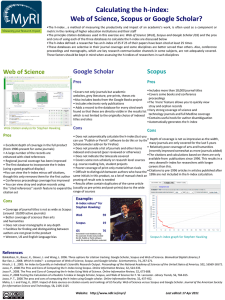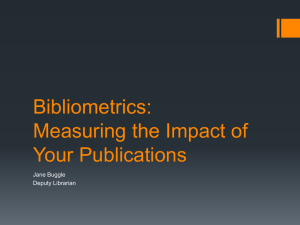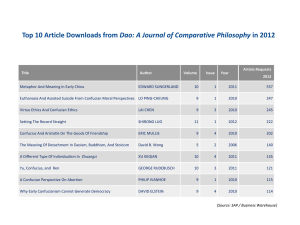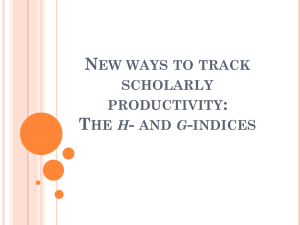Study 2 - University of Florida
advertisement
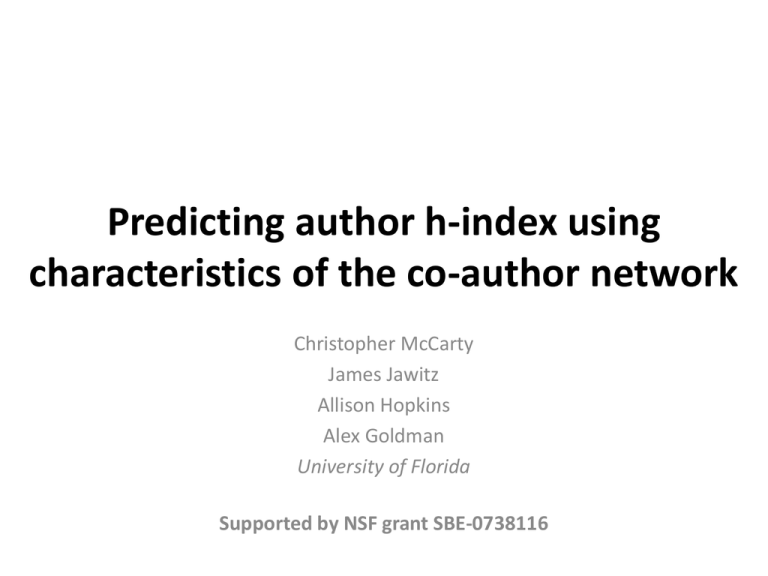
Predicting author h-index using characteristics of the co-author network Christopher McCarty James Jawitz Allison Hopkins Alex Goldman University of Florida Supported by NSF grant SBE-0738116 Background • There is variability in the way people choose collaborators • We investigated how these behaviors affect scientific impact • We will discuss how Vivo could be used to maximize these behaviors Collaboration Behaviors • Number of co-authors – Alone versus many collaborations – Teams of various size • Structure of collaborations – Dyadic interactions versus working in groups – One cohesive group versus many different groups – Disconnected groups versus groups with brokering • Characteristics of co-authors – Working with academics versus non-academics – Working with highly cited authors (Godfather/Godmother) Research Question: How does the choice of collaborators in the co-author (egocentric) network affect this author’s scientific impact? • Many co-authors • Large teams • One highly cited co-author • At least two subgroups • Co-authors working in nonacademic settings Research Design 1. Select a sample of authors from the ISI Web of Science 2. Calculate scientific impact for authors in sample 3. Create co-author network for sample 4. Build a model where: – The dependent variable is scientific impact – The independent variables reflect behaviors by an author in selecting co-authors Scientific Impact – The h-index • A scientist has index h if h of his or her papers have at least h citations each (Hirsch 2005:1) • Hirsch has an h-index of 52 – He published 52 papers that had been cited at least 52 times (as of September 20, 2009) – He published 161 papers not included in his hindex because none of them had been cited more than 52 times Why use the h-index? Advantages • Minimizes bias due to: – Many publications that are not cited – A few publications with many citations • Provides an objective basis for evaluation • Easily calculated from the ISI Web of Science Citation Report Disadvantages • Only includes indexed journal articles (no books or book chapters) • Self-citation can inflate the index • Authors get equal credit regardless of contribution • Comparison across disciplines is controversial (although that is what we are doing) Alternative metrics • • • • • • • • • m-quotient h-sequences h-rate Contemporary h-index Trend h-index AR-index Weighted h-index Tapered h-index Z-index • These all represent attempts to “fix” or “adjust” the h-index • These are all still objective measures relying on citations as the main product of a scientist Why should we care about metrics? (Alison Abbott , David Cyranoski, Nicola Jones,Brendan Maher, Quirin Schiermeier & Richard Van Noorden (2010) “Metrics: Do Metrics Matter?” Nature 465, 860-862) Sample selection • Downloaded all 760,335 articles from ISI Web of Science for 2006 • Parsed the articles into authors (3,441,571 million records) • Unduplicated the list by combining author name and affiliation (3,004,948 records) • Randomly selected 594 authors • Calculated h-index for each author (this involved disambiguation) Distribution of the h-index across the Web of Science (n=594) 60 50 P 40 e r c 30 e n t 20 10 0 0 3 6 9 12 15 18 21 24 27 30 33 36 39 42 45 H-Index 48 51 54 57 60 63 66 69 72 75 78 81 84 Procedure to Create Network • Randomly selected 250 authors from the list of 594 • Identified all authors in articles included in the h-index – Eleven authors had an h of zero resulting in no network – Four authors had co-author networks greater than 350 (one had over 4,000). For these we randomly selected 50. • Calculated all of the edges between co-authors • Imported data into Ucinet for processing – Data are symmetric – For graph-based measures data were dichotomized at ties > 0 Variable Transformation: Respondent h-index (EgoH) EgoH LogEgoH Variable Name Netsize AvgAuthors Components Isolates Betweenness Hierarchy MeanTie Academic MeanAlterh MaxAlterh HofMostEVC Description Behavior – Publish with… Number of Co-authors Number of authors across all Many different authors h-index articles Average authors per article Large teams Structure of collaborations Number of components with Disconnected groups ego removed Number of isolates with ego Disconnected co-authors removed Normalized mean Different connected groups betweenness Extent to which co-authors A highly connected brokering are brokered by single coco-author author Average number of articles Co-authors who publish a lot published between coauthors Characteristics of Co-authors Proportion co-authors in Academics academic setting Average h-index of co-authors High h-index authors Highest h-index among coauthors H-index of most eigenvector central alter One high h-index author Transformation Logarithmic Logarithmic (Var+1) None Removed outlier with 37 isolates Logarithmic None Logarithmic None None Logarithmic One high h-index author who Logarithmic is highly connected Isolates outlier • John Gill, MD • Research in clinical outcomes of organ transplant patients • Publishes many articles with a single co-author 60 50 40 egoh • Research Scientist, Associate Professor of Medicine, Division of Nephrology, University of British Columbia Biv ariate Fit of egoh By is olates0 30 20 10 0 0 10 20 isolates0 30 Correlation among Independent variables Netsize AvgAuthors Components Isolates Betweenness Hierarchy MeanTie Academic Meanalterh AvgAuthors Components Isolates Betweenness Hierarchy MeanTie Academic Meanalterh Maxalterh HofMostEVC 0.3581 0.2128 0.0695 -0.1108 0.3151 -0.3539 -0.0885 0.5258 0.7595 0.593 -0.1195 -0.0607 0.161 -0.226 0.2629 -0.1241 0.1462 0.3116 -0.3478 -0.0674 -0.0059 0.3074 0.1269 0.2715 0.2363 0.288 0.194 -0.0188 0.1172 -0.2392 -0.0707 0.0181 0.0508 0.0814 0.1066 -0.1779 0.042 -0.0572 0.004 -0.0629 -0.2079 0.0791 0.0289 0.1332 0.0112 0.0568 0.2504 -0.2465 -0.0008 0.1783 -0.1693 0.0226 0.774 0.701 Action: Eliminate Maxalterh and HofMostEVC from model Bivariate and Multivariate Models Final Model Multivariate Model Bivariate Models Netsize Coefficient Prob>|t| R-square Coefficient Prob>|t| Coefficient Prob>|t| Partial R-square .59 .0001 .51 .0001 .51 .60 .0001 .73 AvgAuthors .03 .7526 0 - - Components .32 .0001 .09 .07 .0784 Isolates .08 .2992 0 - - Betweenness .15 .1360 0 - - - - Hierarchy 2.93 .0001 .24 1.53 .0001 1.55 .0001 .07 Meantie -.54 .0001 .19 -.21 .0001 -.23 .0001 .02 Academic .32 .2991 0 - - Meanalterh .08 .0001 .21 .024 .0019 .02 .001 .01 Which collaborative behaviors matter? Network size matters • The single most important behavior to increase the h-index is to publish with a lot of different people (Netsize) • This is likely due to the tendency for authors to cite their own work • Consider two authors: – Author A publishes 30 articles as a single author – Author B publishes 15 articles with one or more co-authors – Author B is likely to have a higher h-index because she can leverage the self-citation from co-authors Application of Network Size to Vivo • Vivo will provide a large pool of potential collaborators with similar interests • Scientists can find people with similar funding backgrounds and who have cited the same articles • Vivo will make it possible to find scientists who have published books and book chapters, as well as conference proceedings, not indexed in the Web of Science Other variables • Hierarchy measures the extent to which a network is constrained by a single node – High hierarchy implies a Godfather/Godmother who tends to publish with many co-authors – Egocentric network visualization using Vivo could make it easy to find these brokering nodes • Mean tie strength (Meantie) is negatively associated with the h-index. – As mean tie strength increases the h-index decreases – This is probably due to the negative association with network size • Mean alter h-index (Meanalterh) is positively associated with ego’s h-index – Publishing with co-authors who have high impact increases the h-index – Vivo will make it possible to find highly cited co-authors in their discipline • There is little reward for co-authoring with disconnected groups (Components) Thank You! ufchris@ufl.edu

